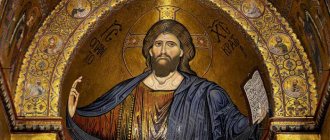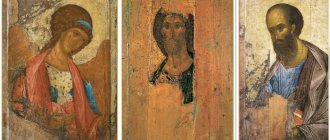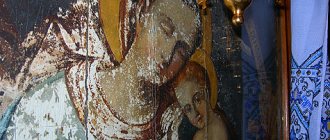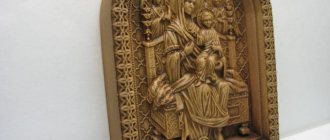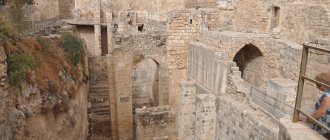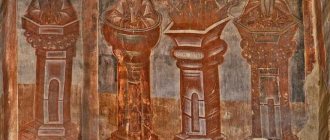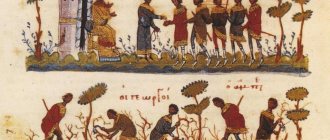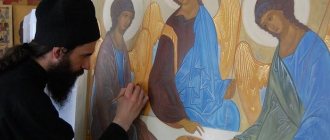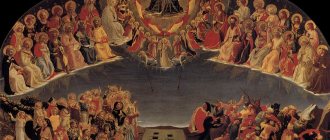The image of the Lord and Savior Jesus Christ is the most important icon in every home. This is an image of God Himself, incarnate and accepting death on the Cross for the sake of people.
There are a number of iconographies of Jesus Christ, many miracles are known from His ancient and new icons. What is the meaning of the iconographic type of Christ the Savior Pantocrator, how to pray to the Lord?
Dear Brothers and Sisters, we will be very glad if you subscribe to our group in, there you will find even more prayers, icons and other interesting information, here is the address link - Orthodox group! We are also pleased to remind you that on the pages of our church store you can find all possible Orthodox goods!
Use of Images in Nominal Christianity
Like representatives of ancient pagan religions, members of nominal Christianity (leaders of the Episcopal Church or those who profess Orthodoxy) always offered their prayers to something visible. The latter worship Jesus Christ, who is part of the Divine Trinity, as God. In accordance with their beliefs, he is often depicted in icons in the arms of Mary as a small child, or as a man with a halo above his head, standing next to two others. On the icons you can also see other ideas of believers about what the real God looks like. They depict Christ as ascending into heaven at the moment when his disciples saw him.
Icon of the Almighty - the power of God
In front of the iconographic face of the Lord Jesus they ask for help in everything, about all troubles, illnesses and difficulties. The image of the Lord is easily recognized by the cross-shaped halo, symbolizing the glory of the Cross, with which the Lord defeated death, and the light shown to his disciples on Mount Tabor.
The image of Christ Pantocrator is the most important in the iconography of Christ. It is found in a “shoulder” (to the beginning of the chest, up to the shoulders) and waist composition. But the most solemn image of the Savior Almighty is the Savior on the throne, where Christ is depicted in full height. This is one of the oldest subtypes of the iconography of the Almighty Savior. The throne is a symbol of God’s power, a reflection of the Old Testament appearances of the Lord of Hosts to the prophets and the words of the Gospel that the Lord will judge people from the throne. The title also reflects the composition of the icon: the Savior is depicted full-face, fully turned towards those praying and sitting on a throne and a scarlet pillow, His feet are at the foot of the throne.
With his right hand Christ blesses people, with his left he holds the open Book. The meaning of the Book is also deeply symbolic and ambiguous: according to the interpretation of the Old Testament, it is the Book of the Testament of God and man, the Book of Life with the names of those who will enter the Kingdom of God, the Good News of the Gospel, and the Apocalypse tells us that it is also the Book of Revelation, closed seven seals, which no one can read except the Savior Himself. The book is also a symbol of Jesus Christ Himself, because, according to the words of the Evangelist John the Theologian, He is the Word of God who came into the world.
Also, if you have a desire, on our pages you can buy an icon of the Savior, or buy an icon of the Lord Almighty!
How God is imagined in non-Christian religions
In non-Christian faiths such as Buddhism and Hinduism, people also worship their gods using images. In the distant past, the Celts worshiped a three-headed god. The heads indicated that such a god was all-seeing and all-knowing. In ancient Egypt, most gods had a human body and an animal head, and in Ancient Greece they often appeared in the guise of strong heroes, possessing invulnerability and other qualities characteristic of people.
However, questions arise. What does a real god look like? Should images be used in worship of the true god?
The meaning of the icon of Jesus Christ
This icon is very well known to people, because a crown with a cross floats above the face of Jesus. This crown indicates the divine principle, as well as the second worldly face of the Almighty. The cross signifies the struggle over death and sinful action, the humility that our Savior showed during his suffering.
The face of the Almighty is singled out from a huge number of holy images. It is represented by six main species, which in turn are represented by twenty subtypes.
“Heavenly Savior”, “Almighty Pantocrator” and “Jesus Christ on the Throne” are the most popular and revered icons that every Orthodox believer knows.
The role of the icon in Orthodoxy
The purpose of this icon is extremely important. It contains a warning about the Supreme Court, which all people must go through, as well as such qualities as warmth and compassion. With the help of this icon, Orthodox people cope with all the obstacles and troubles on their path leading to a high good goal. This holy face of the Lord symbolizes the harmony of worldly and religious existence, and also the torment that Jesus endured for the sake of all mankind.
The Holy Face gives believers compassion in sorrows, calmness, and strength to withstand all obstacles, patience. By offering prayers before this icon, believers express recognition for assistance and help, and also pray for a message of guidance in achieving the goal.
What God Looks Like in the Bible
Have you thought about this? What does the Lord God look like according to the Bible? In the Holy Scriptures of the Old and New Testaments, it can be clearly understood that the true God, who created all living things, who is the Creator of everything, cannot be seen. How do we know this? Among the writings of the Apostle John are the following words: “No man has ever seen God, but the only begotten God, who is at the Father’s breast, told us about him.” It is necessary to note that no one has ever seen God (with a capital G), but the only begotten God (with a small G) told people about him. What is the difference between the first and the second? The first means Almighty God, the Father of Jesus Christ, and the second means the Son of God himself, who lived on earth. From this biblical text it is clear that it is impossible to know what the real God looks like. His photo cannot be seen in any church in the world. On the other hand, Jesus, who also has divine authority from his Father, was seen by people and could learn from him. However, it will not be possible to depict it today either. Despite the fact that Jesus Christ is considered a real historical figure and his existence is confirmed by an ancient historian, such as Josephus, not a single truthful description of the appearance of the Son of God has survived to this day.
What types of icons of the Lord are there:
• Icon of Christ the Almighty and Heavenly Judge. • The face of the Lord in the form of a preacher among worldly people. • In addition to the above images of Jesus, there are holy images of Christ, where he is depicted in the form of a boy or toddler (such images of the Almighty do not form a separate type).
In most images, the Savior is depicted with a cross-shaped halo on his head. This halo is a symbol of the Divine light that the Lord showed to his followers on Mount Tabor. By depicting such a symbol, the two essences of Jesus Christ are denoted - the Heavenly nature and the earthly, human nature.
In almost all images he is depicted holding a book in his hands: open or closed - the Bible, the sacred message of salvation that the Almighty brought to people.
• The holy image of the Lord Pantocrator is an icon that any Christian church must have, usually it is located in the center of the church. In this icon he is depicted during his preaching activities: smooth hair that falls to his shoulders, a small beard and mustache, his right hand is depicted in a blessing gesture, and in his left hand he holds the Bible. • The image with the crown of thorns is a suffering icon. Because this symbolizes the suffering and sins of people, which Jesus, according to the will of his Father, took upon himself.
Why is it impossible to know what the Creator looks like?
As much as we would like to know what God looks like, he cannot be seen for several reasons. Let's consider one of them. To begin with, it is worth paying attention to what is said in the writings of the prophet Moses. While speaking to him, God personally told him, “You cannot see my face, because no man can see me and live.” Why is this not possible? One day Moses was given the opportunity to see part of the glory of God. Scripture tells how this happened. The Almighty told him to stand on the rock. The Creator further explained that he would pass by. Moses needed to hide in a cleft of the rock. And only thanks to the fact that God personally covered him with his hand, the prophet survived. Having given all the orders, the Almighty repeated again: “But you will not be able to see my face.” After God passed before the prophet, Moses' face glowed, so the people asked him to cover his face with a veil, since they were afraid that they would perish. This incident clearly shows that the Lord is the source of enormous strength and power who created all the stars and galaxies. Since he has such power, no person can see him and live on.
Description of the icon of Jesus Christ
The Almighty can be depicted sitting on a throne, in full growth, or as a bust. In one hand he holds a parchment or a Bible. The other hand is depicted as a parting sign. The Bible is depicted either open or, on the contrary, closed. If the Gospel is revealed, then two signs are drawn there: the name of the first and last letters in the Greek alphabet. This means sunrise and sunset.
In this icon, Our Lord is depicted during that period of worldly life during which Jesus held missionary conversations. Around the head there is a round halo with a cross inscribed in it. He wears a blue cape over a red ancient Greek men's dress. The upper cape represents the source of the sky, and the shirt represents human essence, suffering, and majesty. This clothing shows the equinox of the worldly, religious and heavenly.
In what sense can we see God?
However, if we do not know what God looks like, then how can we understand the words that Jesus Christ spoke in his Sermon on the Mount? He said, “Happy are the pure in heart, for they will see God.” The Greek word used in this Bible passage literally means “to see spiritually.” Christ, when on earth, fully reflected the personality of his Father. Therefore, by exercising faith in him and in his sin-atonement sacrifice, we can spiritually see God, that is, know him as a person and draw closer to him. The highest point of vision of God is reached by the anointed ones, who will be able to see the face of God in heaven after the resurrection. There they will rule together with Christ over earthly humanity and will receive instructions from the person of the true Creator.
I believe in One God, the Father Almighty
The main Orthodox prayers “Our Father” and “I Believe” are read in great danger, in difficult circumstances, when a person is very anxious and nervous about the situation. For example, there is an acute problem with housing, they don’t give me salaries on time, and I can’t sit down for my thesis. It's time to pray - with prayer you will not only ask the Lord to resolve the situation, but also calm down yourself, and also with God's help. Situations of prolonged stress cause serious difficulties with the human psyche, so you should not put off the prayer rule - even psychologists are confident in its effectiveness.
“I believe” is what every Orthodox Christian should sincerely believe.
May our Lord and Savior Jesus Christ protect you!
Why do believers need an icon of God?
Jesus taught: “Be like children.” If you ask any child how he imagines God the Father, he will probably say that he is a kind (or strict, but fair) grandfather with a big white beard who sits on the clouds. If the child is already familiar with the basics of Orthodoxy, he can add that Jesus Christ is also sitting there and the Holy Spirit dove is flying (approximately like on the “Co-Throne” icon).
This, of course, is a very primitive and naive idea, but it is important for a simple person to have before him a visible image of his Heavenly Father, who sees through all our worldly affairs and is able to protect us. But we also feel our responsibility before Him: when creating man, He endowed him with free will, so it depends only on us whether we choose the righteous path or the sinful one. And theological subtleties are inaccessible to most believers.
( 4 ratings, average: 4.00 out of 5)
Why you can't portray God the Father
Such champions of the veneration of icons as St. John of Damascus and St. Theodore the Studite argued that the icon of God cannot be painted, since we do not see Him, unlike God the Son - Jesus Christ, Who had two hypostases - human and divine, and the saints who were people. As John says (1:18), “No one has ever seen God.”
The Holy Fathers rejected the icons of the Lord, since they are anthropomorphic, that is, created in the image and likeness of man, the image of God the Father. Theologians define God the Father as the first, initial and causal hypostasis of the Holy Trinity.
The image of God in Christianity
In the Bible, the main book of Christians, there is no description of the appearance of God. The image of Jesus is also absent from the Bible. There is only an image of a Caucasian man that came from somewhere, known to everyone, and canonized by the church. In ancient Rus' they called him “Savior” and they went on campaigns with his image on banners.
No one can now reliably explain where this image came from in Europe. Thus, the old man on the cloud and the tall, long-haired, handsome man with a beard are pure inventions of medieval marketers, without any evidence that God the Father and Jesus Christ have any basis for these images.
What God looks like in Islam
I think that I will not reveal a secret by saying that in Islam there is no description of Allah’s appearance. Moreover, there is a direct ban on drawing icons. This is explained by the words from the same Bible - “do not make yourself an idol.”
So that external attributes do not draw the attention of the believer, so that nothing distracts him from concentrating directly on God. I think that this way of looking at things is very reasonable, in any case, the argument, in my opinion, is weighty.
Image of God in Judaism
It turned out that in Judaism the image of God is also not manifested. Quality, please, but appearance - no! Moreover, as in Islam, in Judaism it is forbidden to depict God! This is motivated by the fact that creating the image of God in oneself must take one’s entire life. This is possible because man is a reflection of the Creator, His image in our world. Think about these words! The image of God must be created in oneself. Nurture it and manifest it into this world!
Amazing thought!
The logical continuation of this thought would be that the external and internal appearance of each of us is the appearance of God! Not all of it, of course, but only some part of it, nevertheless, realizing this, I began to peer much more carefully into people’s faces.
However, if we return to the canons, i.e. to the holy scriptures, then in the Torah we will not find a description of God. If I understand correctly, then it’s not only impossible to depict him, in Judaism you can’t even pronounce the name of God, they prefer to call him simply “Lord.”
How God is portrayed in Buddhism
Buddha images are a dime a dozen. There are so many! But, according to the definition of Buddhism itself, Buddha is not the supreme and only god. Buddhism is not a monotheistic religion. Buddha, translated, means enlightened, but not supreme, self-manifested, etc. and so on. That is, in Buddhism we will not be able to see the image of God either.
What does the Supreme God look like in Rodnoveria, Slavism
Rodnoverie at the moment is such an unformed and vast layer of knowledge, myths, rituals, and other informational husk that I could not find a source that I could trust unconditionally. But even there, the question of what God looks like is not even raised. In any case, I could not find any discussion on this topic anywhere.
Ringing cedars of Russia
I apologize for putting the social movement “Ringing Cedars of Russia” on a par with world religions. But I couldn’t help but do this, because, firstly, the strength of this movement is already noticeable in Russia, and secondly, the ideas and thoughts expressed in the green books are very close to me.
Here are a few thoughts that Anastasia, the main character of V. Maigret’s books, said about God, from which you can roughly imagine what God looks like:
• “God is the interplanetary Mind, Intellect. It is not in a single mass. Half of it is in the extra-material world of the Universe. It is a complex of all energies. The second half is dispersed in parts on Earth, in every person.” • “God is love”
But what does her grandfather say about God in a conversation with Maigret, answering his question, why no one sees God? I quote from the book in its entirety: “Anastasia told me when I was talking to her in the taiga that no one sees God because His thoughts work with great speed and density. But I’m thinking: why doesn’t He want to slow them down so people can look at Him?
The old man raised his wand and pointed at a passing cyclist: “Look, Vladimir.” The bicycle wheel is spinning. There are spokes in the wheel, but you can't see them. They are there, you know it, but the rotation speed does not allow you to see them. Or you can say it differently: “The speed of your thought, your visual perception does not allow you to see them. If a cyclist goes slower, you will see the wheel spokes become greased.
If he stops, you will see them clearly, but the cyclist himself will fall. He will not reach his goal, because he has stopped moving, and all for the sake of what? So that you can see what they are? But what will this give you? What will change in you? Around you?
You will be firmly aware of their existence. And that's all. The cyclist can get up and continue moving, but others will also want to see, and for this he will have to fall again and again.
And for what? - Well, to look at him at least once. - And what will you see? After all, a cyclist lying on the ground will no longer be a cyclist. You'll have to imagine that he was. A God who has changed the speed of his thoughts is no longer God. Wouldn't it be better for you to learn to speed up your thoughts? When you talk to a person, and your interlocutor thinks very slowly, doesn’t this irritate you? Isn’t it painful to slow down the speed of your thoughts, adjusting to him?”
This is the dialogue that took place between Anastasia’s grandfather and the author of the books “The Ringing Cedars of Russia.” But there is one subtle point here that I did not immediately notice. God and God’s thoughts are still slightly different concepts, aren’t they? Or should we assume that the Thought of God = God?
If we continue the analogy, we get, My thought = I! Strongly! Is not it?
But I, this is not just a thought. I am also those fingers that are now tapping the keys while typing this text. I am this and my material body, I am my actions and words. That is, in addition to thoughts, I have some visible, tangible components. To prove my statement, I will give an example: we say, “I thought,” meaning some kind of “I” who realized the thought, processed it and made a decision.
If we are created in the image and likeness, then he must have them too. Or does image and likeness end with thought? Hardly. After all, the creature that created the material world must possess the qualities of the material world, i.e. shape, mass, density, etc.
In general, even in Maigret’s books we do not find a visible image of the supreme, one God.
By the way, the fact that God the creator does not have a manifested form is confirmed by Anastasia herself when she says that when creating the world, God did not conceive a form for himself. Unfortunately, I don’t remember which book she talked about this in.
Image of the Supreme Personality of Godhead in Hinduism
Probably nowhere is there a more detailed description of the pantheon of gods as in Hinduism. As in Christianity, there is a supreme trinity here - Brahma, Vishnu and Shiva. Chief among them is Vishnu.
You can find a great variety of images of them. All are more or less similar to each other. Those. any Hindu can easily distinguish Shiva from Brahma or, for example, Ganesha in any picture.
That is, in Hinduism there is no such self-will in the depiction of God as with the image of Jesus Christ, who is depicted as anyone takes it into his head.
The most interesting thing is that Vishnu, the Supreme God who can manifest himself in any form, also has a Supreme Personality called Krishna. That is, the most, the supreme supreme, there is nowhere higher!
There are also a lot of images of Krishna. Although they have a fairly wide range in the style of the image, in most of them Krishna can be recognized by some characteristic features unique to him.
Moreover, his appearance is not canonized out of nowhere. A description of what it looks like was found in the Vedas. If anyone is interested in reading, find the book Srimad Bhagavatam, fourth canto, part 3, text 44.
There is a lot written there, I did not give a description of Krishna here so as not to confuse the unprepared reader. Let me just say that his appearance is described in comparisons with something beautiful on earth. For example, lotus feet.
I don’t know what image appears in your mind when you hear this phrase, I don’t have any. That is, a physical image does not arise. Only the image of its qualities appears, since the lotus in the Indian tradition personifies purity, innocence and many other good things, then from the phrase “lotus feet” we can only understand “the most beautiful, the purest and most immaculate feet.” What does this look like in reality? That's right, no one knows.
In fact, if you still try to imagine God even according to the descriptions given in the sacred Sanskrit texts, then the physical image of God does not arise.

